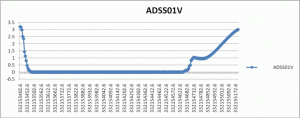WISE saw the solar eclipse

One million and counting
May 31, 2010
Decadal Survey
August 13, 2010WISE is still being eclipsed by the Earth, an effect known as night for those of us living on Earth, but on 11 July 2010 WISE also got eclipsed by the Moon. The graph below shows the output of a coarse Sun sensor (basically a solar cell) falling rapidly as the sunlight powering WISE was cutoff by the Earth’s limb, then rising rapidly 21 minutes later as the eclipse by the Earth ended. But the level stayed at about 30 percent of full sunlight for another 7 minutes due to the penumbra of the Moon. Of course the WISE telescope was looking 90 degrees away from the Sun and took no notice of the eclipse. I’m sure people on Easter Island had a more exciting view.
nwright
Ned Wright, 65 years old, is a professor at UCLA. He did far-infrared observations using a 102-cm balloon-borne telescope for his PhD thesis, and has since observed with the Kuiper Airborne Observatory, and the space-based COBE, WMAP, Spitzer and WISE missions.



5 Comments
Congratulations on full sky coverage! (I think?) As of 8pm PDT July 20 2010, the wise.ssl.berkeley.edu/sky_coverage.html page says 1367672 frames thru 10-201.4; 99.9% to depth > 7
I thought the first pass was complete this past weekend. Just curious- is the coverage page out of date, or are there still some missing spots?
100% of the sky has 4 frames or more, which is what we need for reliability. 99.9% of the sky has 8 frames or more, and 8 frames is the level we use for computing our sensitivity. So that last 0.1% of the sky has slightly worse sensitivity but has been covered.
In practice there are other regions with bigger problems like the area where Jupiter was when we scanned it. Jupiter is awfully bright!
Thank you for the reply! Is the Jupiter-affected area in the region that will be scanned again before the end of the mission? Will Jupiter have moved enough by that time to make a difference?
Unfortunately Jupiter only moves about 5 arc-minutes per day so during the day or so that WISE looked at that longitude Jupiter did not move far enough to give us a good look at what was behind it on the sky. And we will probably run out of hydrogen before we come back to that longitude.
Nice article!!